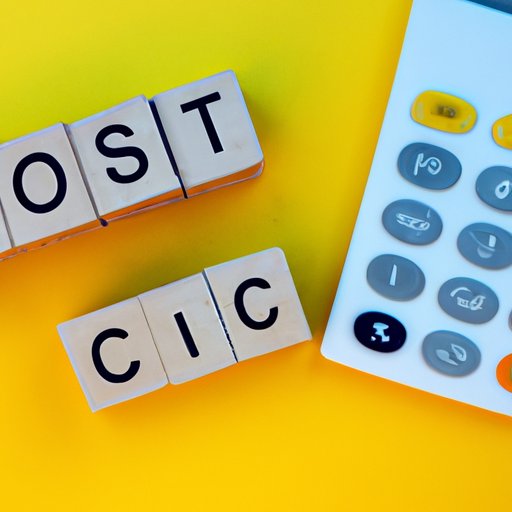
I. Introduction
Businesses of all sizes face a multitude of expenses, including fixed and variable costs. While fixed costs remain constant regardless of the level of production or sales, variable costs fluctuate based on the volume of goods or services produced or sold. Variable costs are an essential part of understanding a business’s overall costs, profitability, and success. In this article, we will explore the concept of variable costs in detail and provide practical advice on how to find, control, forecast, and reduce them.
II. Understanding Variable Costs: A Beginner’s Guide
Variable costs refer to the expenses that vary based on production or sales activities. Common examples of variable costs include direct materials and labor, commissions, shipping, and packaging. Understanding variable costs is crucial for businesses as it impacts the cost of goods sold (COGS) and ultimately determines the profitability of a product or service. By identifying and analyzing variable costs, businesses can make informed decisions about pricing, production, and overall cost management.
It’s important to differentiate variable costs from fixed costs, which remain constant over time. Examples of fixed costs include rent, salaries, and insurance. While both fixed and variable costs impact a business’s bottom line, variable costs have a more direct correlation to sales and production.
By reducing variable costs, businesses can increase profitability, streamline operations, and optimize resources. Conversely, ignoring variable costs can result in inefficiency, waste, and reduced profitability.
III. Five Simple Steps to Calculate Variable Costs
Calculating variable costs is a straightforward process that involves identifying the product or service, identifying the variable cost items, determining the cost per unit of each variable cost item, calculating the total variable cost per unit, and analyzing the results.
Step 1: Identify the product or service. Determine the item or service you want to calculate variable costs for.
Step 2: Identify the variable cost items. Make a list of every expense that fluctuates based on production or sales activities. Examples include direct materials and labor, commissions, shipping, and packaging.
Step 3: Determine the cost per unit of each variable cost item. Divide the total cost of each variable expense by the total units produced or sold. For example, if your direct materials cost $500 for 100 units, the cost per unit would be $5.
Step 4: Calculate the total variable cost per unit. Add up all of the variable expenses per unit to determine the total variable cost per unit.
Step 5: Analyze the results and make necessary adjustments. Use the data to inform decision making on pricing, production, and cost management strategies. For example, if the total variable cost per unit is higher than you anticipated, you may need to adjust pricing or identify cost-cutting measures.
IV. How to Control Variable Costs: Strategies for Success
Effective cost management involves controlling both fixed and variable costs. However, controlling variable costs requires a differentiated approach as it involves managing expenses that fluctuate based on sales and production activities. By controlling variable costs, businesses can increase profitability, improve efficiency, and optimize resources.
There are several strategies for managing variable costs, including negotiation, process improvement, cost tracking, and outsourcing. Negotiation involves working with suppliers to reduce costs, while process improvement focuses on identifying and eliminating inefficiencies in production processes. Cost tracking involves tracking expenses and using data to inform decision-making, while outsourcing involves delegating tasks to external providers to reduce labor costs. Implementing these strategies requires a deep understanding of a business’s operations, suppliers, and customers.
Practical advice for controlling variable costs includes setting clear goals, developing a budget, tracking expenses, analyzing data regularly, and working closely with suppliers and vendors. These strategies can help businesses identify cost-saving opportunities and optimize resources.
V. The Art of Forecasting Variable Costs
Forecasting future variable costs is critical for businesses that want to optimize resources and manage costs effectively. By forecasting variable costs, businesses can make informed decisions about pricing, production, and overall cost management. Several techniques and tools can be used for forecasting variable costs. These include trend analysis, regression analysis, and predictive modeling.
Trend analysis involves using historical data to identify patterns and future trends. Regression analysis involves analyzing data to identify relationships between variables, while predictive modeling uses algorithms to predict future trends based on historical data. These techniques can be used to inform decision-making and develop informed cost management strategies.
Real-world examples of businesses that have successfully forecasted variable costs include Uber and Amazon. Uber uses predictive analytics to forecast demand and adjust pricing, while Amazon uses trend analysis to anticipate seasonal changes in demand and adjust inventory levels accordingly.
VI. Increase Profitability by Reducing Variable Costs: Best Practices
Reducing variable costs is an effective way to increase profitability, streamline operations, and optimize resources. Several best practices can help businesses minimize variable costs, including outsourcing, process optimization, and lean practices.
Outsourcing involves delegating tasks to external providers to reduce labor costs and increase efficiency. Process optimization focuses on identifying and eliminating inefficiencies in production processes, while lean practices involve minimizing waste and maximizing customer value. By implementing these best practices, businesses can improve efficiency, reduce costs, and increase profitability.
Real-world examples of businesses that have successfully reduced their variable costs include Apple and Procter & Gamble. Apple outsources the production of its devices to contract manufacturers to reduce labor costs, while Procter & Gamble uses lean practices to minimize waste and optimize resources.
VII. Conclusion
Variable costs are an essential part of understanding a business’s overall costs, profitability, and success. By identifying, controlling, forecasting, and reducing variable costs, businesses can optimize resources, improve efficiency, and increase profitability. Practical advice for managing variable costs includes setting clear goals, developing a budget, tracking expenses, analyzing data regularly, and working closely with suppliers and vendors. Businesses that prioritize variable cost management are better equipped to navigate the ever-changing business landscape and achieve long-term success.
Additional resources for readers who want to learn more about variable costs and cost management include industry associations, online courses, and business consultants.




